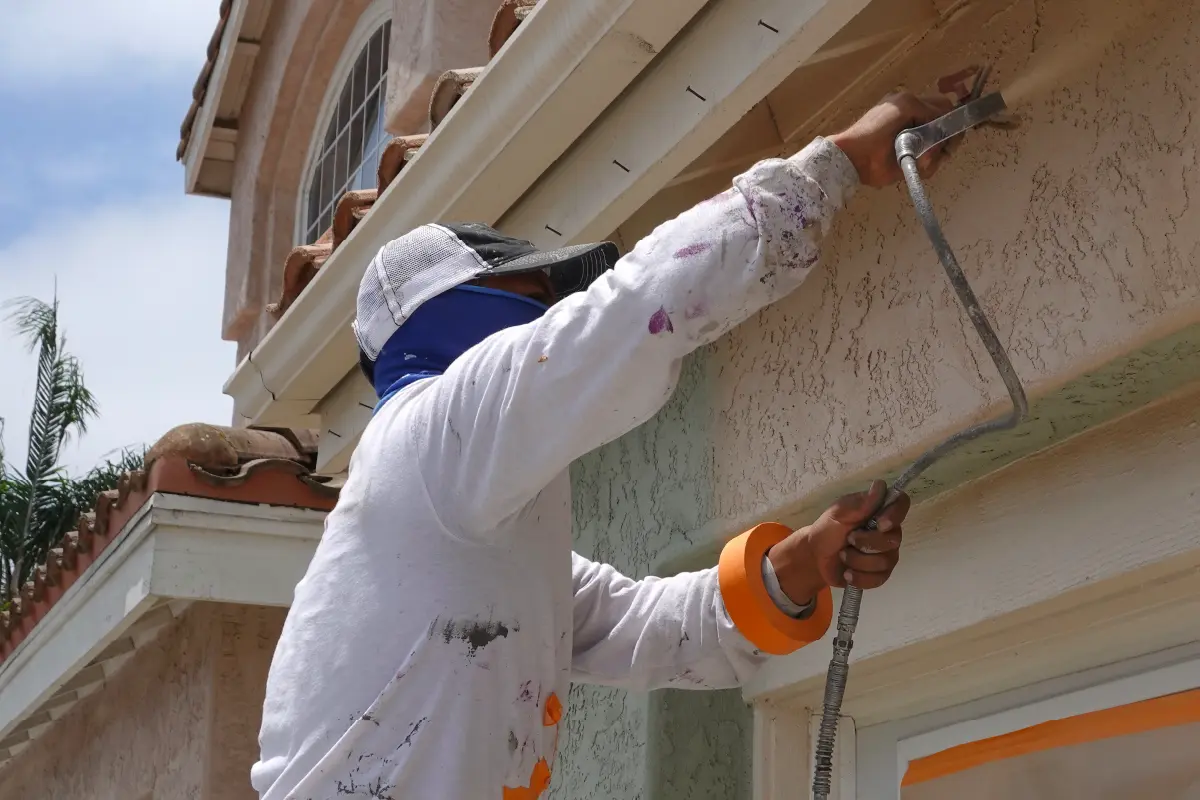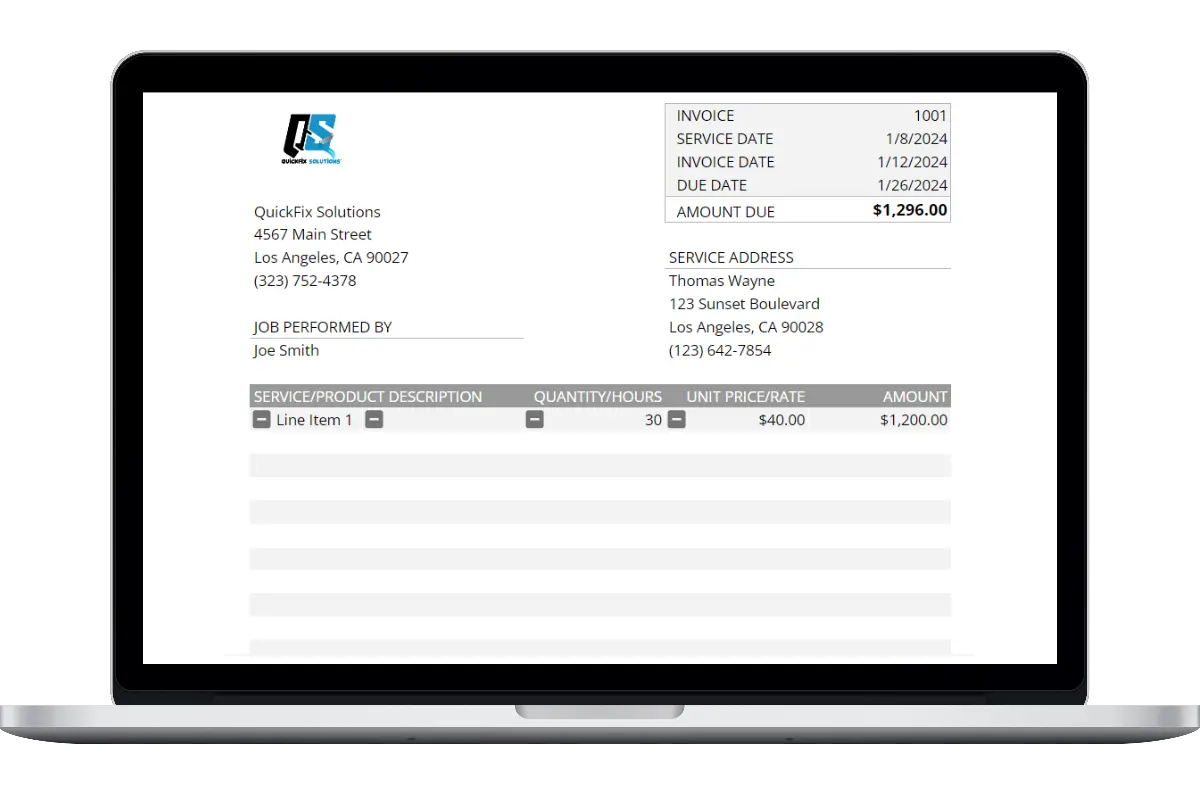
Do you have a knack for painting within the lines? Do you enjoy creating more livable and workable spaces for others? Do you have a modest understanding of color theory and how it can completely change an environment? If so, becoming a painter might be a career path for you. And, if you have an entrepreneurial spirit, taking the next step to start a painting business might be where it’s at.
But simply calling yourself a painter and the owner of a painting business and painting the interiors—or exteriors—of homes for your family members and friends might not cut it. That’s why we’ve taken our years of experience supporting service industries to outline the steps to take not just a painting business but a thriving one. So, if you are wondering how to start a painting business, this article is for you.
Let’s get to it.
Steps Needed to Start Your Painting Business
- 1. Gain Painting Experience & Skills
- 2. Draft Your Business Plan
- 3. Register Your New Business
- 4. Get Business Insurance
- 5. Set Up Banking and Accounting
- 6. Determine Your Services
- 7. Set Your Prices
- 8. Invest in Modern Painting Equipment
- 9. Land Your First Client
- 10. Impress Clients with High-Quality Service
- 11. Consider Hiring Painters
- 12. Scale With Painting Business Management Software
- Housecall Pro Has the Painting Management Software You Need to Grow Your Business
Starting a painting business can be super exciting. Not only will it help reap you a decent paycheck—the average painting contractor makes about $22.00 per hour—you’ll be in the business of beautifying spaces.
When homeowners add a fresh coat of interior paint, it can improve their home value by about 5%. And that’s not to mention just the change in appearance as paint covers up all those knicks, scratches, and blemishes that develop over time.
So, without further ado, let’s get into the steps needed to set your new painting business off on the right path to success.
1. Gain Painting Experience & Skills
To start a successful painting business, you need to have the skills and experience, especially if you want to scale and grow your business. One of the best ways to do this is to apply for an apprenticeship or start a position with a local painting company in your area. This will give you the opportunity to work under the guidance of an established professional painter. You’ll learn tips and tricks to do the job well, and you’ll get a better handle on the best tools to use for each type of painting job and the best types of paints to use for various projects.
Remember how we mentioned color theory earlier? Well, if you really want to go the extra mile, take some time to study this concept a bit. This will give you insights into the emotions that are brought out by various colors and how certain colors work well together—and those that do not. Your future customers will appreciate this extra level of expertise that you can provide.
2. Draft Your Business Plan
Many aspiring business owners think that the business plan is just a piece of paper that needs to be completed in order to get a business formally established or to apply for small business lending. And while it is true that a business plan is needed for that, it’s far more important than many people realize.
Your business plan should include the following key components.
- Executive Summary: A brief overview of your business goals and plans.
- Company Description: Detailed information about your business, mission, and objectives.
- Market Analysis: Research your industry, market size, target customers, and competitors.
- Organization and Management: Structure of your business and information about the ownership and management team.
- Services or Products: Description of the painting services or products you will offer.
- Marketing and Sales Strategy: Define your marketing strategies for attracting and retaining customers.
- Financial Projections: Revenue and expense forecasts, including profit and loss statements.
- Funding Request: If seeking funding, details on your funding needs and potential future plans.
- Appendix: Any additional information, such as resumes, permits, or legal documents.
Here are some additional tips that can help you with some of the components we mentioned above.
Conduct Thorough Market Research
Before getting into the business, you need to understand your local market. This involves gauging the demand for painting services, identifying your target customers, and analyzing your competitors. Knowing who your competitors are and what they offer will help you find ways to stand out.
Choose Your Business Model
Decide whether you want to focus on residential or commercial painting or a mix of both. Residential painting often involves interior and exterior jobs for homes, while commercial painting might include offices, schools, and retail spaces. Each has its own set of pros and cons, so consider your skills and local market needs.
Budget Wisely
Your business plan should include a budget for startup costs and ongoing expenses. This covers everything from buying brushes and paint to marketing your services. Projecting your revenue is also a must to understand how much work you need to bring in to stay profitable.
Set Clear Goals
Finally, set clear, achievable goals for your business. This will help you track your progress and stay motivated. Whether it’s landing your first client or hitting a certain revenue target, having milestones will keep you focused and moving forward.
3. Register Your New Business
With your business plan under your belt, it’s time to register your business. This process is integral to helping you with proper taxation and will also boost your credibility with potential customers.
First, choose a business structure. A sole proprietorship is the simplest but offers no personal liability protection. An LLC (Limited Liability Company) provides liability protection and flexible tax options. A corporation offers strong liability protection but involves more complex regulations.
Next, pick a memorable business name and obtain a federal EIN (Employer Identification Number). Register your business with state and local authorities.
Finally, check if you need any specific licenses or permits to operate a painting business in your area. Proper registration and licensing will help you operate legally and build client trust.
4. Get Business Insurance
Business insurance is something that many small business owners overlook, but we can’t emphasize enough how important this is. This type of insurance can help protect you in the event of injuries while on the job, inadvertent property damage caused by you or one of your employees, or potential litigation.
Here are the types of business insurance we suggest for painting businesses.
- General Liability Insurance: Covers accidents, property damage, and injuries that might happen on the job.
- Workers’ Compensation: Protects your employees if they get hurt while working and is often required by law.
- Commercial Auto Insurance: Covers vehicles you use for business in case of accidents.
To choose the right policy:
- Compare quotes from multiple providers to get the best deal. You can also work directly with an insurance broker who can do this on your behalf.
- Understand what each policy covers, including any exclusions or limits.
- Select a plan that fits your needs and keeps your business protected.
5. Set Up Banking and Accounting
Next on the list is to get set up with a business banking account. While you can use your personal account, it will make things much more complicated at the end of the year when it is time to work with your accountant and figure out your business taxes.
Here are some tips for financial success.
Separate Personal and Business Finances
Separating your personal and business finances simplifies accounting and tax filing. It helps you clearly track business expenses and income, making it easier to manage your finances. This can also pay off later if you are ever audited and need to provide proof of business income as a comparison to personal expenses. Open a line of credit and get a business credit card where you can separate transactions for your new business like buying essential painting supplies and expensive equipment
Consider Hiring a Professional Accountant
As your business grows, think about hiring a professional accountant. They can guide you in compliance with tax regulations and provide valuable financial advice. Plus, it can be helpful to have a tax professional in your corner to help you with self-employment taxes, how to pay yourself a paycheck and manage any questions that might come up from the Internal Revenue Service (IRS) or your state Department of Revenue.
Use Accounting Software
We recommend using QuickBooks accounting software. It helps track expenses, manage invoices, and generate financial reports, making your financial management more efficient.
Get In Touch: 858-842-5746
Grow your painting business to new heights
On average, Pros increase monthly revenue generated through Housecall Pro by 50% after their first year.
See plan options and feature breakdown on our pricing page.
6. Determine Your Services
Have you thought about the types of painting services that you want to offer to your prospective customers? Do you want to stick to interior paint jobs, or are you comfortable working on those exterior jobs? Do you prefer working with residential painting clients, or do you want to work in the commercial space? Are you adept at wallpaper installation? You may have the skills and interest to do all of the above.
When figuring out how to start a painting contractor business, it is important not to take on too much or too little so that you create customer disappointment or don’t bring in enough revenue to cover your expenses and pay you a paycheck. Be sure to check the competition to see what is offered and look for gaps where you might be able to differentiate yourself.
7. Set Your Prices
Now, it is time to determine your painting business pricing strategy. And we need to emphasize how important it is to take job costing seriously. About 82% of small businesses fail because of a lack of positive cash flow. Think about that for a moment. Why does this happen? Because businesses fail to set prices that are not just competitive in the market but will help drive a profit. When your expenses going out become more than the revenue coming in, you’ve got a problem,
Here is what to consider.
Research Local Market Rates
- Conduct competitor analysis to understand what others in your area charge.
- Make sure your prices are competitive yet profitable by comparing them with local market rates.
Calculate Costs
- Use a formula that includes labor, materials, overhead, and desired profit margins.
- Make sure all costs are accounted for to avoid underpricing your services.
Consider Different Pricing Strategies
- Flat Rates: Good for straightforward jobs with predictable time and resource requirements.
- Price Per Hour Rates: Useful for projects with variable time commitments.
- Per-Square-Foot Charges: Effective for larger projects where size impacts the workload.
8. Invest in Modern Painting Equipment
Next in our step-by-step guide on how to start a paint business is to actually invest in the tools you need to do the job. And we know what you’re going to ask—how much does it cost to start a painting business?
Here’s the thing. For non-franchise painting start-ups, the cost can vary dramatically. You may be able to get started for as little as a few hundred dollars, especially if you already have a vehicle that you can use to get from project to project. But, the chances are that you will need to make some broader investments, and quickly, if you really want to scale and grow your business. At Housecall Pro, we estimate that you’ll need anywhere from $3,000 to $15,000 to get going. If you will need a vehicle, it might cost you more.
9. Land Your First Client
With all of the legalities and insurance squared away and the tools needed to take on your first job, it’s time to land that first client. But how do you do just that? Well, it’s going to require some marketing and advertising investment, unless, of course, your first client is a family member or friend willing to pay you for the job and give you some positive reviews.
Here are some tips to help you start growing some brand awareness.
- Create a Google Business Profile to help potential clients find your business online and read reviews. Invest in review management software to make sure you never miss a review, good or bad.
- Build a professional website with details about your services, pricing, and contact information. Make sure your website is user-friendly and shows expertise and experience in the painting space. This will help you demonstrate authority so that customers will trust you with their painting needs.
- Leverage social media platforms like Facebook, Instagram, and LinkedIn to promote your business.
- Generate marketing campaigns to let others know you are out there, ready to offer amazing painting services for their home or business.
- Share photos of your interior or exterior painting work, client testimonials, and special offers on social media.
- Network within your local community by attending local events and joining business groups.
- Partner with local home improvement stores or real estate agents for referrals.
- Build a portfolio showcasing your previous work with before-and-after photos.
- Include testimonials from satisfied clients to build credibility and attract potential clients.
10. Impress Clients with High-Quality Service
With all this effort you have put into getting your painting business off the ground, now you need to create an amazing customer experience that people will want to tell others about. Have you ever heard the adage that people are more likely to tell others about bad experiences than good ones?
Consider this statistic—an estimated 13% of consumers will tell at least 15 people or more if they had a bad experience. And, we hate to be the bearer of bad news, but the truth is that they are far less likely to tell others about good experiences.
This means that providing an excellent customer experience is so important for the future of your business. And when you’ve completed a job well done, be sure to ask the customer directly to share a review or testimonial on your Google Business Profile. People are more likely to do business with companies that others have good things to say.
Download our free resource: The Ultimate Guide to Customer Experience
11. Consider Hiring Painters
When the work starts rolling in, you will need to hire some help. While you can certainly plan to be a one-person show, you might end up at a standstill before you know it. After all, with just one person, you can only do so much. That’s why we suggest getting into the hiring process sooner rather than later.
Here’s how to find some great painters to help you handle the increased workload and grow your business.
- Advertise job openings on job boards like Indeed, Glassdoor, and LinkedIn.
- Share the job opening on your business website and social media channels.
- Network for referrals from industry contacts and local business groups.
- Encourage current employees to refer qualified candidates.
- Conduct thorough interviews to assess candidates’ experience and skills.
- Ask about their previous work, specific techniques, and problem-solving abilities.
- Look for candidates with proven painting experience and a portfolio of past work.
- Consider their familiarity with different types of paints, tools, and techniques.
- Check references to verify work history and performance.
- Ask about the candidate’s reliability, work ethic, and professionalism.
- Confirm that the candidate’s values align with your company culture.
- Look for good communication skills and a positive attitude.
- Provide a skills test to have candidates complete a small painting task.
- Evaluate their attention to detail, speed, and quality of work.
12. Scale With Painting Business Management Software
With any service-related business, there are a lot of back-office-type tasks to manage. And doing these manually won’t likely cut it these days. That’s where painting business management software can be a lifesaver.
For example, scheduling software can make sure that you don’t overschedule or underschedule your services. It will make sure there is enough time to get from place to place, too. Estimating software will help you determine how much to charge for jobs so that you can provide an accurate proposal each and every time. After all, it’s hard to go back to a customer after the fact and ask for more money because you didn’t price it out right the first time. And that leads us to invoicing software, which can help you generate a professional invoice to send to your customer for payment.
Housecall Pro Has the Painting Management Software You Need to Grow Your Business
You might be wondering when to invest in painting management software. And our answer to that question is NOW. The sooner you can automate various processes and create a digital record of invoices and payments, the better. Plus, scheduling software is practically a non-negotiable to help you prevent customer disappointment.
At Housecall Pro, we make all this easy. Start your free trial today!
Frequently Asked Questions
-
How profitable is a painting business?
-
A painting business can be highly profitable, with profit margins typically ranging from 15% to 45%, depending on things such as location, service quality, and operational efficiency. Success hinges on effective cost management, competitive pricing, and consistent work volume.
High demand for painting services in residential and commercial markets often provides ample opportunities for steady income. Additionally, offering specialized services, such as eco-friendly paints or decorative finishes, can further enhance profitability by attracting niche markets.
-
How much does it cost to start a painting business?
-
At Housecall Pro, we estimate that you’ll need anywhere from $3,000 to $15,000 to start a painting business. If you need a vehicle, the cost might be higher. This budget covers essential items like painting tools and equipment, initial inventory of paints and supplies, marketing and advertising, business registration, insurance, and any necessary licenses or permits.
Investing in a professional website and accounting software will help streamline your operations and attract clients.
-
Do you need a license to start a painting business?
-
The need for a license to start a painting business varies by state. For example, in California, any contractor, including a painting and decorating contractor, who works on projects costing $500 or more must be licensed by the California Contractors State License Board (CSLB).
In Tennessee, painters require a state Home Improvement license for remodeling existing residential homes for jobs between $3,000 and $24,999. Although an examination is not required, applicants must provide a bond and a sample contract. Jobs of $25,000 or more require a Contractor’s license.
-
What equipment do I need to start a painting business?
-
To start a painting business, you’ll need essential equipment like high-quality brushes and rollers, drop cloths, ladders, and scaffolding. Invest in paint sprayers for larger jobs and various paint trays and buckets. Safety gear, including masks, gloves, and goggles, is so important.
Don’t forget surface preparation tools such as sanders, scrapers, and tape. A reliable vehicle for transporting equipment is necessary. Additionally, using painting business software from Housecall Pro can help manage appointments, and invoices, and streamline operations efficiently.
-
How do you register a painting business?
-
To register a painting business, start by choosing a unique business name and selecting your business structure (e.g., sole proprietorship, LLC, corporation). Obtain an Employer Identification Number (EIN) from the IRS for tax purposes.
Register your business with your state’s Secretary of State office and comply with local regulations, including any required licenses or permits. Set up a business bank account to keep finances separate. Finally, consider getting business insurance to protect against potential liabilities.






